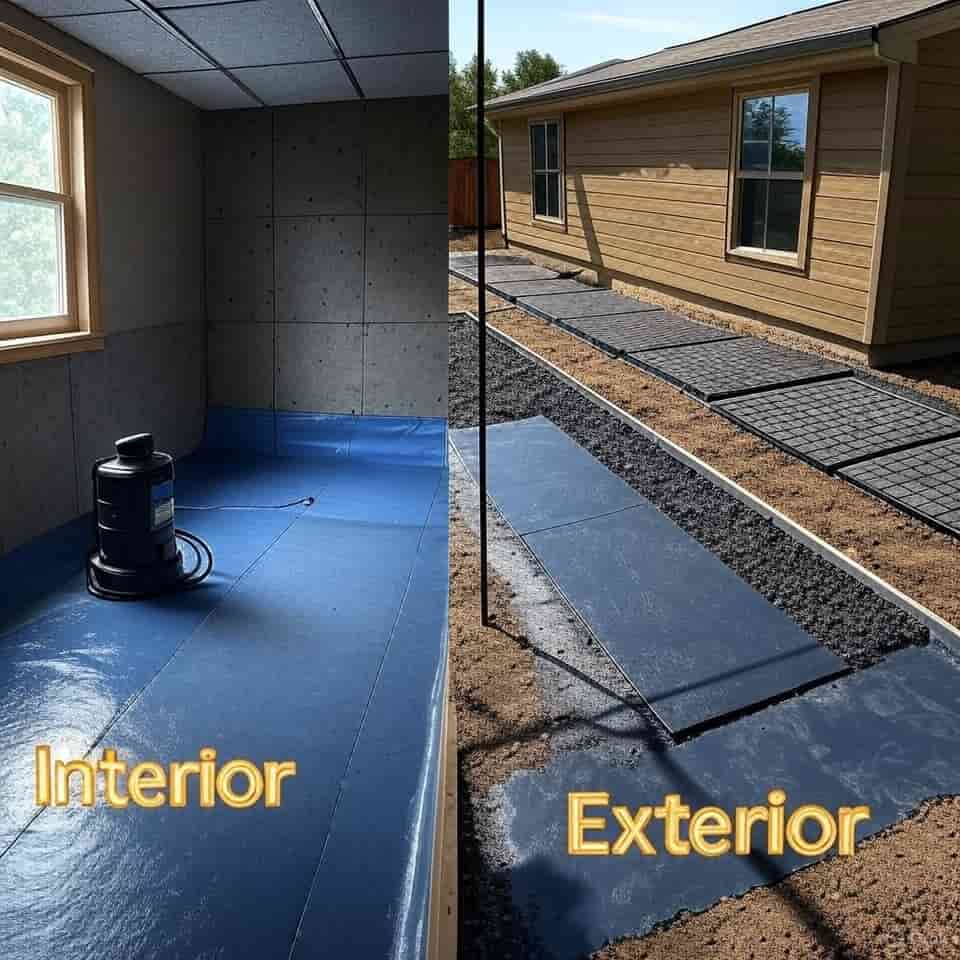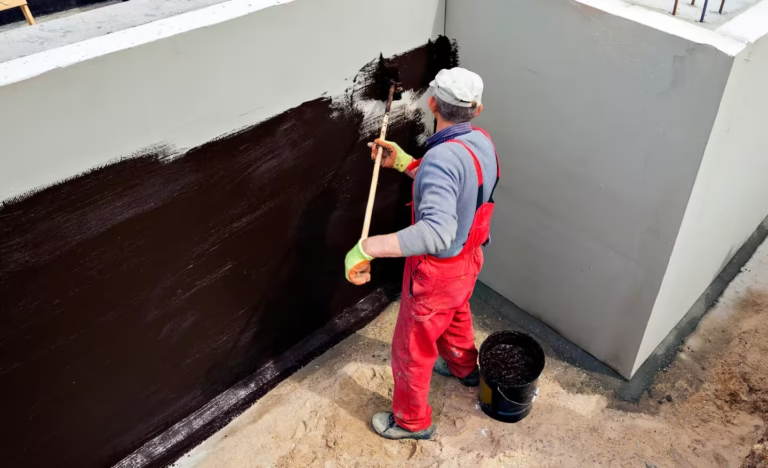Let me tell you something about basements – they can be a real pain when water decides to invite itself in.
I’ve seen my fair share of soggy basements over the years, and trust me, it’s never a pretty sight. Water damage isn’t just about those annoying puddles on the floor.
It’s about the mold that starts growing on your walls, the musty smell that never seems to go away, and the serious structural damage that can happen if you ignore the problem.
Now, if you’re dealing with basement water issues, you’ve got two main ways to tackle it: from the inside or from the outside. I’m going to walk you through both methods so you can figure out which one makes the most sense for your home.
Understanding Basement Waterproofing
So what’s basement waterproofing all about? It’s pretty simple – you’re trying to keep water from getting into your basement and causing all sorts of problems. Think of it like putting a raincoat on your foundation.
You might need to waterproof your basement if you notice:
- Water leaking through the walls or floor
- Cracks in your foundation
- That damp, musty smell that won’t go away
- Visible mold growing on surfaces
- Water stains on your walls or floor
I had a client last year who ignored those little water stains in the corner of her basement. Six months later, we were tearing out moldy drywall and replacing damaged floor joists. Not fun, and definitely not cheap.
When you’re figuring out how to waterproof your basement, you need to consider a few things. What’s the climate like where you live? Do you get tons of rain or snow? What kind of soil surrounds your foundation? Is it clay that holds water or sandy soil that drains well?
The design of your foundation matters too. Older homes often have stone foundations that need different treatment than poured concrete. I’ve worked with basement remodel contractors who’ve had to completely change their approach based on the age of the home.
Understanding Interior Basement Waterproofing
What Is Interior Waterproofing?
Interior waterproofing is exactly what it sounds like – you’re dealing with water issues from inside your basement. Instead of preventing water from getting to your foundation, you’re managing water that’s already made its way in.
Here’s how it typically works: You install a drainage system inside your basement that collects water and directs it to a sump pump, which then pumps the water away from your house. It’s kind of like creating a detour for water that’s already breached your defenses.
Interior Waterproofing Methods
There are several ways to waterproof from the inside:
First, there’s waterproof coatings and sealants. These are paints or sealers that you apply directly to your basement walls. I’ve used these a bunch of times in homes with minor moisture issues. You just clean the wall really well, apply the coating, and it creates a barrier that keeps moisture from seeping through.
Then you’ve got interior drainage systems. This usually involves installing drain tile along the perimeter of your basement floor. The drain tile collects water and channels it to a sump pump. I installed one of these in my own home about five years ago, and it’s been working great.
Vapor barriers are another option. These are typically plastic sheets that you install on your basement walls to prevent moisture from entering. They’re pretty good for controlling humidity in your basement.
Lastly, there’s crack injection. If you’ve got cracks in your foundation, you can inject them with epoxy or polyurethane to seal them up. I did this for a neighbor last summer – he had this one stubborn crack that leaked every time it rained. Fixed it in about an hour.
Pros and Cons of Interior Waterproofing
Let’s talk about the good stuff first:
Interior waterproofing is usually cheaper than exterior. You don’t have to dig around your foundation, which saves a ton of labor costs.
You can do it any time of year. Unlike exterior waterproofing, you’re not at the mercy of the weather.
Some methods, like applying waterproof coatings, are DIY-friendly if you’re handy.
It’s less disruptive to your landscaping. No need to tear up your flower beds or move your deck.
But there are downsides too:
Interior waterproofing manages water that’s already inside rather than preventing it from getting in. So you’re not solving the root problem.
It doesn’t address structural issues in your foundation. If you’ve got cracks that are causing structural problems, interior waterproofing won’t fix that.
Some methods, like interior drainage systems, take up space in your basement. That might be an issue if you’re planning to finish your basement.
You might need to run your sump pump regularly, which means higher electricity bills and potential noise.
Understanding Exterior Basement Waterproofing
What Is Exterior Waterproofing?
Exterior waterproofing takes a different approach. Instead of managing water inside your basement, you’re stopping it from reaching your foundation in the first place. It’s like putting up an umbrella instead of mopping up rain that’s already fallen.
The basic idea is to create a barrier around the outside of your foundation that keeps water away. It’s more intensive than interior waterproofing, but it addresses the root of the problem.
Exterior Waterproofing Methods
Let’s break down the common exterior waterproofing techniques:
External waterproof membranes are probably the most common. This involves digging around your foundation and applying a thick waterproof coating or membrane to the exterior walls. I helped with one of these projects last fall. It was a big job – took a week to dig around the whole house and apply the membrane.
French drains are another popular option. You dig a trench around your foundation, lay perforated pipe surrounded by gravel, and it collects and diverts water away from your house. They work really well, especially in homes built on slopes where water naturally flows toward the foundation.
Exterior drain tile systems work similarly to interior ones, but they’re installed outside your foundation. They collect water before it reaches your foundation walls and direct it away from your house.
And don’t forget about proper grading and gutters. Sometimes the simplest solution works best. Making sure the ground slopes away from your foundation and your gutters direct water well away from your house can prevent a lot of water problems.
Pros and Cons of Exterior Waterproofing
The good news about exterior waterproofing:
It prevents water from reaching your foundation in the first place, which is better than dealing with water that’s already inside.
It can address structural issues with your foundation while you’re at it. If you find cracks during the excavation, you can repair them properly.
It protects your foundation from freeze-thaw cycles, which can cause cracks to expand over time.
It typically lasts longer than interior solutions because you’re addressing the source of the problem.
The not-so-good news:
It’s expensive. You’re looking at major excavation work around your house, which means heavy equipment and lots of labor.
It’s disruptive to your landscaping. You’ll likely need to remove plants, decks, porches, or anything else along your foundation.
It’s weather-dependent. You can’t do this work in frozen ground or during heavy rain seasons.
It usually requires professional help. This isn’t typically a DIY project unless you’re really experienced with excavation and foundation work.
Interior vs. Exterior Basement Waterproofing: Side By Side Comparison

| Factor | Interior Waterproofing | Exterior Waterproofing |
|---|---|---|
| Cost | Lower ($1,500-$5,000 typically) | Higher ($8,000-$15,000 typically) |
| Disruption | Minimal | Significant (excavation required) |
| DIY Potential | Some methods are DIY-friendly | Usually requires professionals |
| Longevity | 5-10 years for most methods | 15-25 years or more |
| Effectiveness | Manages water after entry | Prevents water from entering |
| Best For | Minor water issues, humidity control | Serious water problems, structural issues |
| Season | Can be done year-round | Weather-dependent (no frozen ground) |
| Space Impact | May reduce basement square footage | No impact on interior space |
So how do you decide which method is right for your home? Let me break it down for you based on what I’ve seen work in different situations.
Interior waterproofing makes the most sense when:
- You’re on a tight budget
- Your water issues are minor
- You need a quick solution
- Your landscaping would be too expensive or difficult to restore
- You’re dealing with humidity rather than actual water intrusion
Exterior waterproofing is probably the way to go when:
- You have serious water problems
- You want a long-term solution
- You’re already planning to excavate around your foundation for other reasons
- Your foundation has structural issues that need repair
- You want to prevent water from damaging your foundation in the first place
Here’s a simple breakdown of the key differences:
I remember a job I did a couple years ago for a family in an older home. They initially wanted interior waterproofing because it was cheaper. We installed a drainage system and sump pump, but they still had issues during heavy rains. Eventually, they bit the bullet and went with exterior waterproofing too. It was expensive, but they haven’t had a drop of water in their basement since.
Conclusion
Here’s what it comes down to: there’s no one-size-fits-all solution for basement waterproofing. The right approach depends on your specific situation, budget, and goals.
If you’re dealing with minor moisture issues and you’re on a tight budget, interior waterproofing might be all you need. Apply some waterproof coating, maybe install a dehumidifier, and see if that solves your problem.
But if you’ve got serious water issues or you want to solve the problem once and for all, exterior waterproofing is probably worth the investment. Yes, it costs more upfront, but it could save you money in the long run by preventing water damage to your foundation and everything in your basement.
In many cases, the best approach is actually a combination of both methods. Use exterior techniques to keep water away from your foundation, and interior methods as a backup plan for any moisture that still finds its way in.
Whatever route you choose, don’t ignore water in your basement. I’ve seen too many homeowners put off dealing with moisture problems, only to face much bigger, more expensive issues down the road. A little prevention and maintenance now can save you a ton of headaches later.



